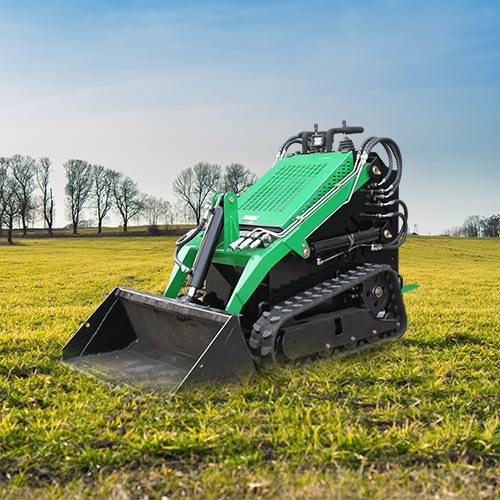Wheel Loader vs Skid Steer.In the world of heavy machinery, two popular workhorses stand out: the wheel loader and the skid steer. These versatile pieces of equipment play pivotal roles across multiple industries, each boasting unique capabilities and functionalities. Understanding the distinctions between these machines is crucial for selecting the right one for specific tasks.
Introduction
When it comes to heavy-duty tasks, the wheel loader and skid steer reign supreme. Wheel loaders, also known as front loaders, are robust machines equipped with a large bucket at the front designed for various materials handling. Skid steers, on the other hand, are compact, agile machines with a distinctive skidding mechanism, enabling swift maneuverability in tight spaces.
Design and Functionality

Wheel loaders are characterized by their large wheels, articulated steering, and a front-mounted bucket. They excel in loading and transporting materials in construction, mining, and agriculture. In contrast, skid steers boast a compact design, utilizing a skidding mechanism for turning, making them ideal for tasks requiring agility and maneuverability, such as landscaping and site cleanup.
Versatility and Applications
The wheel loader finds its niche in tasks requiring heavy lifting and loading, while skid steers thrive in confined spaces, performing tasks like grading, digging, and material handling. The comparative analysis of their capabilities in different applications highlights their specialized functionalities.
Maneuverability and Operation
Wheel loaders, with their larger size, offer stability and comfort for extended operation, excelling in varied terrains. Skid steers, due to their compactness, outshine in navigating tight spaces and intricate job sites, providing unparalleled maneuverability.
| Aspect | Wheel Loaders | Skid Steers |
|---|---|---|
| Size and Design | Larger, bulkier design with articulated steering | Compact design with a skid-steering mechanism |
| Maneuverability | Better suited for open spaces and varied terrains | Exceptional in tight spaces and confined job sites |
| Turning Radius | Typically larger turning radius due to size | Extremely tight turning radius for agile maneuvering |
| Versatility | Suitable for moderate maneuverability needs | Excellently adaptable to intricate work environments |
| Operator Visibility | Generally good visibility from the cabin | Excellent visibility due to the machine’s compact size |
| Comfort and Stability | Offers stability and comfort during extended operation | Compactness might compromise some operator comfort |
| Terrain Adaptability | Handles varied terrains with stability | Navigates uneven terrain effectively |
| Specialized Tasks | Excels in heavy lifting and material handling tasks | Perfect for tasks in confined spaces and intricate work |
Performance and Efficiency
Assessing loading capacities, fuel efficiency, and maintenance requirements reveals the performance disparities between the two. Wheel loaders generally boast higher loading capacities but might consume more fuel, while skid steers are fuel-efficient but might have lower capacities.
Cost Considerations
The initial investment and operational costs play a significant role in decision-making. While wheel loaders have higher upfront costs, their operational efficiency might balance out the initial expenses. Skid steers, with lower initial costs, might incur higher operational expenses.
Training and Skill Requirements
Operational knowledge and skill requirements differ for each machine, influencing the choice based on the available workforce expertise and training feasibility.
Adaptability to Industries
Various industries, such as construction, agriculture, and landscaping, favor either wheel loaders or skid steers based on their specific needs and operational requirements. However, there are sectors where both find applications, showcasing their adaptability.
Environmental Impact
In terms of emissions and eco-friendliness, both machines have their pros and cons, affecting their suitability in environmentally conscious projects.
Technology Integration
Advancements in technology continually enhance the functionalities and efficiencies of both wheel loaders and skid steers, paving the way for future innovations and trends.
Pros and Cons Comparison
Each machine comes with its set of advantages and drawbacks, necessitating a comprehensive evaluation before making a choice.
Decision-Making Factors

Factors influencing the selection between wheel loaders and skid steers include task requirements, operational needs, and budget considerations.
Real-World Examples
Illustrating case studies or real-world scenarios in various industries helps in understanding practical applications and performance.
Future Trends and Developments
Anticipating future advancements in technology and design aids in making informed decisions and aligning with upcoming industry trends.
Conclusion:Wheel Loader vs Skid Steer
In conclusion, the wheel loader and skid steer, though serving different purposes, stand as indispensable assets in various industries. Understanding their differences in design, functionality, performance, and cost aspects is pivotal in making informed decisions.
FAQs
Are wheel loaders and skid steers suitable for the same tasks?
While they have some overlapping functionalities, wheel loaders excel in heavy lifting and material handling, ideal for construction and mining. Skid steers, on the other hand, thrive in tight spaces, making them perfect for tasks like landscaping and site cleanup.
Which machine is more cost-effective in the long run?
The cost-effectiveness depends on various factors like initial investment, operational costs, and specific task requirements. Wheel loaders generally have higher upfront costs but might balance it out with operational efficiency. Skid steers have lower initial costs but might incur higher operational expenses.
Do wheel loaders require more maintenance compared to skid steers?
Maintenance needs vary based on usage and conditions. Wheel loaders, being larger and handling heavier loads, might require more frequent maintenance compared to skid steers. However, proper maintenance schedules can optimize the lifespan of both machines.
Can skid steers handle heavy lifting tasks as effectively as wheel loaders?
Skid steers have lower loading capacities compared to wheel loaders, so they might not be as effective for heavy lifting tasks. While they are versatile, their strength lies in agility and maneuverability rather than sheer lifting power.
Are there any hybrid models combining features of both wheel loaders and skid steers available in the market?
Yes, there are hybrid models available that attempt to merge the functionalities of both wheel loaders and skid steers. These models aim to offer a balance between heavy lifting capabilities and maneuverability, catering to specific industry needs.

